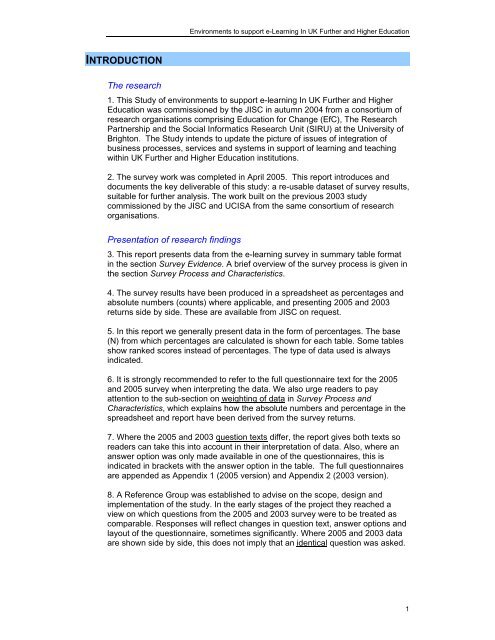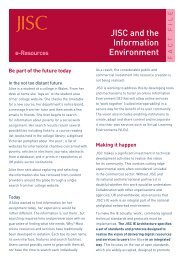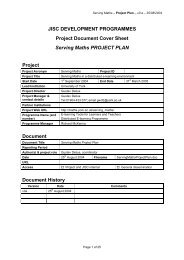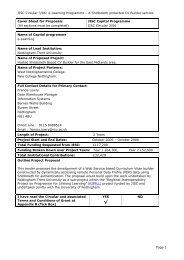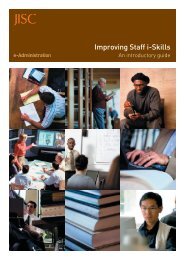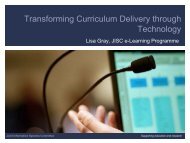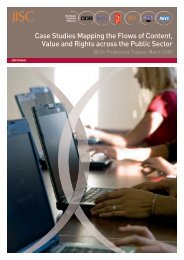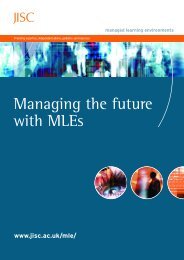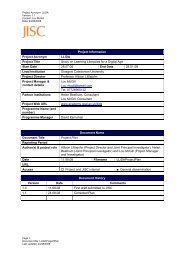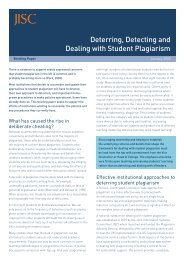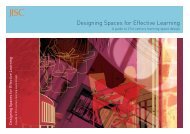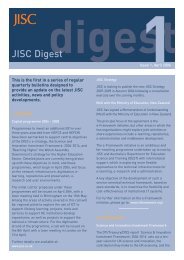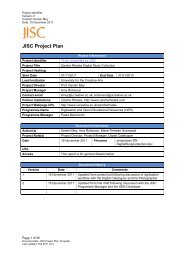study of environments to support e- learning in uk further and ... - Jisc
study of environments to support e- learning in uk further and ... - Jisc
study of environments to support e- learning in uk further and ... - Jisc
Create successful ePaper yourself
Turn your PDF publications into a flip-book with our unique Google optimized e-Paper software.
Environments <strong>to</strong> <strong>support</strong> e-Learn<strong>in</strong>g In UK Further <strong>and</strong> Higher Education<br />
INTRODUCTION<br />
The research<br />
1. This Study <strong>of</strong> <strong>environments</strong> <strong>to</strong> <strong>support</strong> e-<strong>learn<strong>in</strong>g</strong> In UK Further <strong>and</strong> Higher<br />
Education was commissioned by the JISC <strong>in</strong> autumn 2004 from a consortium <strong>of</strong><br />
research organisations compris<strong>in</strong>g Education for Change (EfC), The Research<br />
Partnership <strong>and</strong> the Social Informatics Research Unit (SIRU) at the University <strong>of</strong><br />
Brigh<strong>to</strong>n. The Study <strong>in</strong>tends <strong>to</strong> update the picture <strong>of</strong> issues <strong>of</strong> <strong>in</strong>tegration <strong>of</strong><br />
bus<strong>in</strong>ess processes, services <strong>and</strong> systems <strong>in</strong> <strong>support</strong> <strong>of</strong> <strong>learn<strong>in</strong>g</strong> <strong>and</strong> teach<strong>in</strong>g<br />
with<strong>in</strong> UK Further <strong>and</strong> Higher Education <strong>in</strong>stitutions.<br />
2. The survey work was completed <strong>in</strong> April 2005. This report <strong>in</strong>troduces <strong>and</strong><br />
documents the key deliverable <strong>of</strong> this <strong>study</strong>: a re-usable dataset <strong>of</strong> survey results,<br />
suitable for <strong>further</strong> analysis. The work built on the previous 2003 <strong>study</strong><br />
commissioned by the JISC <strong>and</strong> UCISA from the same consortium <strong>of</strong> research<br />
organisations.<br />
Presentation <strong>of</strong> research f<strong>in</strong>d<strong>in</strong>gs<br />
3. This report presents data from the e-<strong>learn<strong>in</strong>g</strong> survey <strong>in</strong> summary table format<br />
<strong>in</strong> the section Survey Evidence. A brief overview <strong>of</strong> the survey process is given <strong>in</strong><br />
the section Survey Process <strong>and</strong> Characteristics.<br />
4. The survey results have been produced <strong>in</strong> a spreadsheet as percentages <strong>and</strong><br />
absolute numbers (counts) where applicable, <strong>and</strong> present<strong>in</strong>g 2005 <strong>and</strong> 2003<br />
returns side by side. These are available from JISC on request.<br />
5. In this report we generally present data <strong>in</strong> the form <strong>of</strong> percentages. The base<br />
(N) from which percentages are calculated is shown for each table. Some tables<br />
show ranked scores <strong>in</strong>stead <strong>of</strong> percentages. The type <strong>of</strong> data used is always<br />
<strong>in</strong>dicated.<br />
6. It is strongly recommended <strong>to</strong> refer <strong>to</strong> the full questionnaire text for the 2005<br />
<strong>and</strong> 2005 survey when <strong>in</strong>terpret<strong>in</strong>g the data. We also urge readers <strong>to</strong> pay<br />
attention <strong>to</strong> the sub-section on weight<strong>in</strong>g <strong>of</strong> data <strong>in</strong> Survey Process <strong>and</strong><br />
Characteristics, which expla<strong>in</strong>s how the absolute numbers <strong>and</strong> percentage <strong>in</strong> the<br />
spreadsheet <strong>and</strong> report have been derived from the survey returns.<br />
7. Where the 2005 <strong>and</strong> 2003 question texts differ, the report gives both texts so<br />
readers can take this <strong>in</strong><strong>to</strong> account <strong>in</strong> their <strong>in</strong>terpretation <strong>of</strong> data. Also, where an<br />
answer option was only made available <strong>in</strong> one <strong>of</strong> the questionnaires, this is<br />
<strong>in</strong>dicated <strong>in</strong> brackets with the answer option <strong>in</strong> the table. The full questionnaires<br />
are appended as Appendix 1 (2005 version) <strong>and</strong> Appendix 2 (2003 version).<br />
8. A Reference Group was established <strong>to</strong> advise on the scope, design <strong>and</strong><br />
implementation <strong>of</strong> the <strong>study</strong>. In the early stages <strong>of</strong> the project they reached a<br />
view on which questions from the 2005 <strong>and</strong> 2003 survey were <strong>to</strong> be treated as<br />
comparable. Responses will reflect changes <strong>in</strong> question text, answer options <strong>and</strong><br />
layout <strong>of</strong> the questionnaire, sometimes significantly. Where 2005 <strong>and</strong> 2003 data<br />
are shown side by side, this does not imply that an identical question was asked.<br />
1


